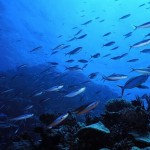As the stories previously reported on this blog will tell you, the world is beginning to make changes towards a low carbon economy, and, the potential of offshore wind power in driving this change in the energy sector is now being realised.
 Offshore wind, key in fighting climate change, does have an impact on marine environments – something which researchers and offshore wind developers are aware of and are developing their knowledge.
Offshore wind, key in fighting climate change, does have an impact on marine environments – something which researchers and offshore wind developers are aware of and are developing their knowledge.
A new study, ‘Greening Blue Energy’, published by the International Union for the Conservation of Nature (IUCN) and written in collaboration with E.ON and the Swedish International Development Cooperation Agency, discusses offshore wind farms and their effects on marine biodiversity.
In the long term, offshore wind farms can be beneficial to the local ecosystems, the study finds. One of the biggest ways wind farms achieve this is in protecting marine species from trawling – among the most severe threat to the marine environment.
Environmentalists criticise trawling for its lack of selectivity – sweeping up both desired and non-desired fish of legal and illegal size. Tons of unwanted fish are discarded each year, dying needlessly.
“Long term trawling exclusion enhances abundance of several species of fish within the whole wind farm area and the effects can be considered large,” states the study.
Boulders that are used to protect the foundations of wind turbines can also offer shelter to marine species by acting as a kind of artificial reef. “It is certain that the wind turbines and scour protections will function as artificial reefs for several species of fish,” the study says.
However, during the construction phase in particular, an offshore wind farm can disturb the marine environment by the noise created, electromagnetic fields and changed water conditions.
“Moving away from oil, gas and coal is vital to avoid the worse impacts of climate change, in this context on marine ecosystems,” says Dan Wilhelmsson, Scientific Coordinator at IUCN and co-author of the report. “At the same time, we need to make sure that what we call blue energy, which includes the offshore renewable sources, is also green and doesn’t exacerbate existing stresses on the marine environment.”
The IUCN urges more research and thorough maritime spatial planning to minimise the risks: “Continued careful monitoring of offshore wind energy developments and their actual impacts on marine wildlife will be vital to generate reliable data and help ensure that offshore wind energy fulfils its sustainable potential,” said Nadine McCormick from the IUCN.
Offshore wind energy development in the European Union is accelerating and could potentially supply 12-16% of the EU’s electricity by 2030, the equivalent of 25,000 wind turbines, the IUCN says.
Read the report and have your say by commenting below.







 Comments
Comments

